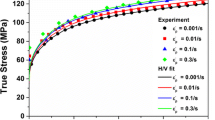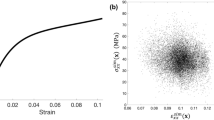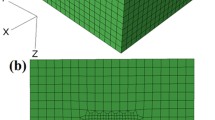Abstract
The predictability of strain distributions and the related prediction of hardening and failure plays a central role in tool and process design for any metal forming process. Studying yielding behaviour, it was discovered that for various well established yield loci no satisfying agreement between DIC (digital image correlation) measurement of strain distribution and simulation result could be obtained, even after optimization of parameters based on associated flow assumption. In parallel, crystal plasticity simulations were investigated with the objective to predict the relation between stress and strain ratios for a large number of load cases based on texture measurement. To include macroscopic data, a secondary strategy uses cruciform tension specimen as defined in ISO16842 to obtain strain and stress ratios. The resulting relations were then applied separately as input parameters for the plastic yield description. Both approaches reach high agreement between forming experiment and simulation. Against the previous assumption, the output can be obtained with either anisotropic or free shape yield loci and associated flow description. The methodology discussed provides an alternative and challenges to rethink the definition of yielding for aluminium alloys on the example of an AA6014-T4 aluminium alloy.










Similar content being viewed by others
References
Hirsiger S (2020) A virtual testing method based on crystal plasticity for macroscopic constitutive models. Dissertation, ETH Zurich
Hirsiger S, Berisha B, Hippke H, Hora P (2019) Predicting plastic strain anisotropy of AA6016-t4 and DC05 by mulitobjective parameter calibration of crystal plasticity models and coupling strategies with macroscopic models. In: XV International Conference on Computational Plasticity. COMPLAS2019 Eccomas. https://doi.org/10.3929/ethz-b-000386362
Kuwabara T (2014) Multiaxial stress tests for metal sheets and tubes for accurate material modeling and forming simulations. Acta Metall Slovaca 20(4):428–437. https://doi.org/10.12776/ams.v20i4.423
Barlat F, Brem JC, Yoon JW, Chung K, Dick RE, Lege DJ et al (2003) Plane stress yield function for aluminum alloy sheets - Part 1: Theory. Int J Plasticity. https://doi.org/10.1016/S0749-6419(02)00019-0
Yoon JW, Barlat F, Dick RE, Chung K, Kang TJ (2004) Plane stress yield function for aluminum alloy sheets - Part II: FE formulation and its implementation. Int J Plasticity. https://doi.org/10.1016/S0749-6419(03)00099-8
Stoughton TB (2002) A non-associated flow rule for sheet metal forming. Int J Plasticity. https://doi.org/10.1016/S0749-6419(01)00053-5
Stoughton TB, Yoon JW (2008) On the existence of indeterminate solutions to the equations of motion under non-associated flow. Int J Plasticity 24(4):583–613. https://doi.org/10.1016/j.ijplas.2007.07.002
Vegter H, Van Den Boogaard AH (2006) A plane stress yield function for anisotropic sheet material by interpolation of biaxial stress states. Int J Plasticity. https://doi.org/10.1016/j.ijplas.2005.04.009
Raemy C, Manopulo N, Hora P (2017) On the modelling of plastic anisotropy, asymmetry and directional hardening of commercially pure titanium: A planar Fourier series based approach. Int J Plasticity. https://doi.org/10.1016/j.ijplas.2017.02.010
Hao S, Xianghuai D (2020) Interpolation-based plane stress anisotropic yield models. Int J Mech Sci 178:105612. https://doi.org/10.1016/j.ijmecsci.2020.105612
Cazacu O, Plunkett B, Barlat F (2006) Orthotropic yield criterion for hexagonal closed packed metals. Int J Plasticity 22:1171–1194. https://doi.org/10.1016/j.ijplas.2005.06.001
Verma RK, Kuwabara T, Chung K (2011) Haldar, A Experimental evaluation and constitutive modeling of non-proportional deformation for asymmetric steels. Int J Plasticity. https://doi.org/10.1016/j.ijplas.2010.04.002
Yoshida F, Uemori T (2002) A model of large-strain cyclic plasticity describing the bauschinger effect and workhardening stagnation. Int J Plasticity 18:661–686
Barlat F, Gracio J, Lee M, Rauch E, Vincze G (2011) An alternative to kinematic hardening in classical plasticity. Int J Plasticity 27:1309–1327
Coppieters S, Hakoyama T, Eyckens P, Nakano H, Van Bael A, Debruyne D et al (2018) On the synergy between physical and virtual sheet metal testing: calibration of anisotropic yield functions using a microstructure-based plasticity model. Int J Mater Form. https://doi.org/10.1007/s12289-018-1444-1
Ogasawara Y, Hakoyama T, Takeda H, Kuwabara T, Barlat F (2019) Material modeling and forming limit analysis of 6014-T4 aluminium alloy sheet In: Proceedings of Numiform 2019. pp 135–138
Pilthammer J, Banabic D, Sigvant M (2020) Bbc05 with non-integer exponent and ambiguities in nakajima yield surface calibration. Int J Mater Form. https://doi.org/10.1007/s12289-020-01545-0
Park T, Chung K (2012) Non-associated flow rule with symmetric stiffness modulus for isotropic-kinematic hardening and its application for earing in circular cup drawing. Int J Solids Struct 49(25):3582–3593. https://doi.org/10.1016/j.ijsolstr.2012.02.015
Lou Y, Yoon JW (2017) J2-j3 based anisotropic yield function under spatial loading. Procedia Engineer 207:233–238. https://doi.org/10.1016/j.proeng.2017.10.767
Yoon JW, Barlat F, Dick RE, Karabin ME (2006) Prediction of six or eight ears in a drawn cup based on a new anisotropic yield function. Int J Plasticity. https://doi.org/10.1016/j.ijplas.2005.03.013
Tian H, Brownell B, Baral M, Korkolis YP (2017) Earing in cup-drawing of anisotropic al-6022-t4 sheets. Int J Mater Form 10:329–343. https://doi.org/10.1007/s12289-016-1282-y
Güner A, Yin Q, Soyarslan C, Brosius A, Tekkaya AE (2011) Inverse method for identification of initial yield locus of sheet metals utilizing inhomogeneous deformation fields. Int J Mater Form 4:121–128. https://doi.org/10.1007/s12289-010-1009-4
Vegter H, ten Horn C, Abspoel M (2009) The Corus-Vegter Lite material model: Simplifying advanced material modelling. Int J Mater Form. https://doi.org/10.1007/s12289-009-0640-4
Pijlman HH, Huétink J, Carleer BD, Vegter H (1998) Application of the Vegter yield criterion and a physically based hardening rule on simulation of sheet forming In: Numisheet 98, pp 763–768
Gorji M (2015) Instability and fracture models to optimize the metal forming and bending crack behavior of al-alloy composites, Dissertation, ETH Zurich
Manopulo N, List J, Hippke H, Hora P (2015) A Non-Associated Flow Rule Based Yld2000-2D Model In: IDDRG 2015, pp 1–5
Logan RW, Hosford WF (1980) Upper-bound anisotropic yield locus calculations assuming 〈111〉-pencil glide. Int J Mech Sci. https://doi.org/10.1016/0020-7403(80)90011-9
Stoughton TB, Yoon JW (2011) Paradigm change: Alternate approaches to constitutive and necking models for sheet metal forming. In: AIP Conference Proceedings, ISBN 9780735409491. https://doi.org/10.1063/1.3623589, vol 1383, pp 15–34
Hippke H, Manopulo N, Yoon JW, Hora P (2018) On the efficiency and accuracy of stress integration algorithms for constitutive models based on non-associated flow rule. Int J Mater Form 11(2):239–246. https://doi.org/10.1007/s12289-017-1347-6
ISO 16842 (2014) Metallic materials – Sheet and strip – Biaxial tensile testing method using a cruciform test piece. International Organization for Standardization, pp 16842
Roters F, Diehl M, Shanthraj P, Eisenlohr P, Reuber C, Wong SL, et al. (2019) Damask – the düsseldorf advanced material simulation kit for modelling multi-physics crystal plasticity, damage, and thermal phenomena from the single crystal up to the component scale. Comp Mater Sci 158:420–478. https://doi.org/10.1016/j.commatsci.2018.04.030
Quey R, Dawson P, Barbe F (2011) Large-scale 3d random polycrystals for the finite element method: Generation, meshing and remeshing. Comput Method Appl M 200(17):1729–1745. https://doi.org/10.1016/j.cma.2011.01.002
Berisha B, Hirsiger S, Hippke H, Hora P, Mariaux A, Leyvraz D, et al. (2019) Modeling of anisotropic hardening and grain size effects based on advanced numerical methods and crystal plasticity. Arch Mech 71(4-5):489–505. https://doi.org/10.24423/aom.3150
Han F, Diehl M, Roters F, Raabe D (2020) Using spectral-based representative volume element crystal plasticity simulations to predict yield surface evolution during large scale forming simulations. J Mater Process Tech 116449:227. https://doi.org/10.1016/j.jmatprotec.2019.116449
Hirsiger S, Berisha B, Raemy C, Hora P (2018) On the prediction of yield loci based on crystal plasticity models and the spectral solver framework. In: Journal of Physics: Conference Series, pp 1–7. https://doi.org/10.1088/1742-6596/1063/1/012056
Hora P, Tong L, Berisha B (2013) Modified maximum force criterion, a model for the theoretical prediction of forming limit curves. Int J Mater Form 6(2):267–279. https://doi.org/10.1007/s12289-011-1084-1
Volk W, Suh J (2013) Prediction of formability for non-linear deformation history using generalized forming limit concept (gflc). In: Numisheet 2014. https://doi.org/10.1063/1.4850035, vol 1567, p 556
Acknowledgements
This work was conducted within the scope of a Project (No.: 26515.1 PFIW-IW) with Innosuisse - Swiss Innovation Agency. Experimental support was received by E. Polatidis and J. Capek from the Paul-Scherrer-Institute (PSI).
Author information
Authors and Affiliations
Corresponding author
Ethics declarations
Conflict of interests
The authors declare that they have no conflict of interest.
Additional information
Publisher’s note
Springer Nature remains neutral with regard to jurisdictional claims in published maps and institutional affiliations.
Rights and permissions
About this article
Cite this article
Hippke, H., Hirsiger, S., Berisha, B. et al. Optimized and validated prediction of plastic yielding supported by cruciform experiments and crystal plasticity. Int J Mater Form 13, 841–852 (2020). https://doi.org/10.1007/s12289-020-01569-6
Received:
Accepted:
Published:
Issue Date:
DOI: https://doi.org/10.1007/s12289-020-01569-6




